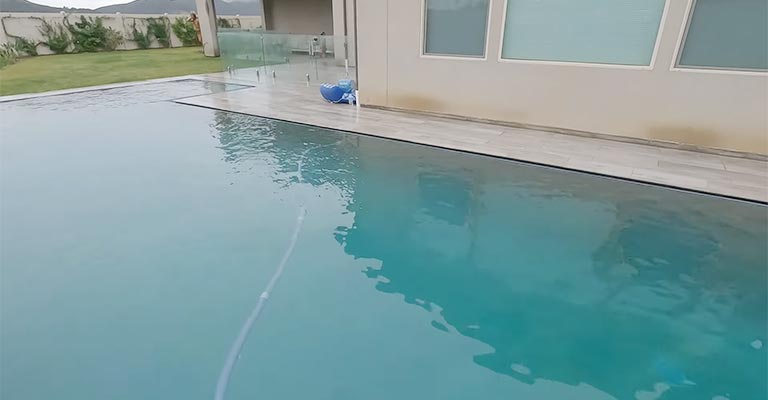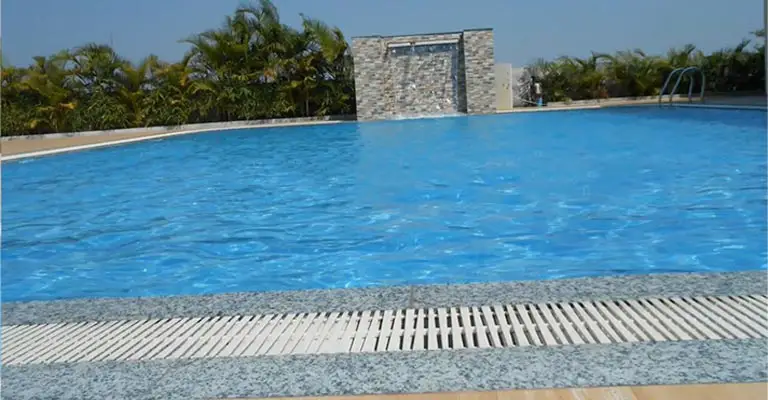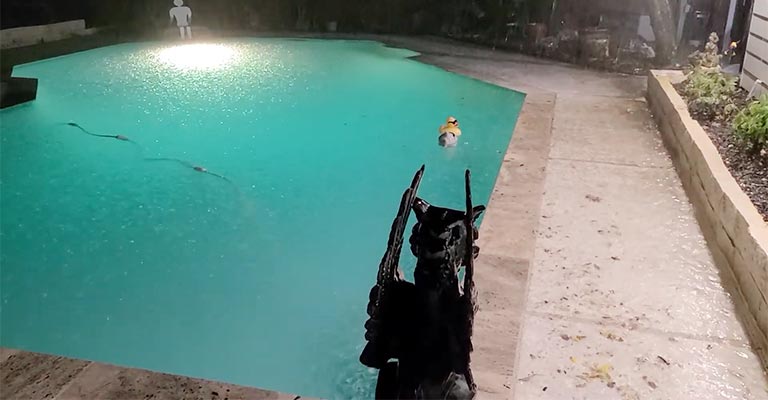After a heavy downpour, the serenity of owning a pool can sometimes be disrupted by the sight of overflowing water.
A pool overflowing from rain is a common concern pool owners face, especially in regions prone to sudden and intense rainstorms.
Excessive rainfall can lead to water level imbalances, potential damage, and compromised water quality. Addressing this situation promptly and effectively is crucial to maintaining the functionality and aesthetics of your pool.
Whether you’re a seasoned pool caretaker or a new pool owner facing this issue for the first time, understanding how to manage pool overflows will equip you with the knowledge needed to swiftly tackle this post-rain challenge.
An Overflowing Pool
You won’t typically see your pool overflow when it rains. In the meantime, you wait for the extra water to settle into the ground, drain a little pool water and bring us a sample for testing.
Once all the chemicals are added, you will be able to swim again. But what if it rains frequently, there’s one huge downpour, and the yard doesn’t drain well?
Depending on where you are, you may encounter landscaping and grading issues, damage to your pool and even your home, and unsafe water to swim in. Here are some solutions to some of these fundamental issues.
Pool Overflow Dangers
A pool overflow with no proper management can lead to several consequences. Before we begin, let’s briefly review what can happen if your pool overflows during a storm.
Water Damage
Your grass will absorb water that spills over the edge of your pool. If you have one, it may be possible to handle the extra volume of water with your patio’s drainage system.
In a storm, however, you can be certain that a drain or soil cannot handle all the excess water. It is unfortunate that failing to prevent rising water levels in your pool might result in flooding inside your home in the event that another storm comes along.
A home can cost up to $1,500 to eliminate just an inch of water, so you should avoid this scenario at all costs.
Chemical Disruption
Chemists are responsible for keeping your pool’s water clean. The presence of excess rainwater leads to an imbalance in these chemicals, which can result in unsanitary pool water.
Sometimes, your pool’s algae growth can become so rapid that swimming is unsafe. The water must be drained first in order to resolve this issue.
What To Do if Your Pool is Overflowing?

You should follow the following pool advice if there is a deluge of rain in your area and your swimming pool is about to overflow.
During periods of heavy rain, keeping an eye on the water levels and running your chlorine generator is a good idea.
You should test your water after the rain ceases and balance the levels accordingly. If you are unsure, it would be helpful to examine a sample of pool water at your local pool shop.
- You should turn off your pool pump and your filter to waste. You should now turn the pump back on.
- If you have a cartridge filter, pump your waste water to the waste line if you have a three-way valve.
- Drain your pool water until you reach the ¾ mark on the skimmer.
- Shut off the pump and reconnect the filter to its regular filter line.
- Recover chlorine levels in your chlorinator by running it for 24 hours or as required.
- Check your water balance as necessary.
Draining Your Pool
To begin with, you should remove extra water from your pool so your water chemistry can be the focus of your attention.
So, what do you do if your yard floods and there is nowhere for the water to go? It won’t be possible for your yard to hold more water, so you’ll have to let it absorb some of the water.
Below are some methods for lowering the water level:
- You can siphon the water to lower the levels. Don’t forget to pay attention to where you put the water. Know your city’s rules if you are draining it down the street drain.
- You should wait a few hours if your backyard is too full of water. If you want to siphon the water out of the pool, you can connect your hose to a spigot and place the other end in it.
- Once the spigot is turned on, turn the hose until you see water coming out. After that, unscrew it from the spigot and cap the end of the hose. Once that is done, take the end to the drain and let it drain.
- Pump drains can be used. Some pumps come with drain spigots, and using this is much easier than siphoning. You should connect one end of your hose to the spigot and one end of the hose to the drain. Activate the pump by opening the spigot.
Submersible pumps are an option. Your other options may not be practical because you have too much water, so this one may be your best option. Ensure your pump is ready, follow the directions, and stand back.
Will I Need To Prime My Pump Before Turning It Back On?
Pre-priming your pump is unnecessary if it still holds its prime in the case of a pump that does not maintain its prime.
In the meantime, if you have removed it from its fixed location to dry it out, you will need to prime it again.
What Do I Do If My Pool Pump Has Been Underwater?
There is a high probability that this will occur during floods. You should unplug and turn off the device safely once the power is disconnected.
Before turning the pump motor back on, give it ample time to dry out completely. It usually takes 36-72 hours for this to happen.
Avoid an Overflowing Pool

To prevent an overflowing pool or minimize its effects, there are several things you can do.
As a first step, you should lower the water level in your pool before the storm. At least lower the weather forecast by a few inches.
The second thing you need to do is get your yard’s drainage in order. A lack of drainage can cause several problems for homeowners, and you’ll be helping your home and pool in the process.
An excellent way to prevent pool overflows is to prevent them from happening in the first place. By preparing in advance, you can save yourself time, headaches, and thousands of dollars.
Pre-Draining The Pool
Depending on the forecast (or how good your weather forecaster is), you can drain your pool before it rains.
As a result, your pool does not overflow, and rainfall drains off properly without adding extra load to your yard. A properly pre-drained pool serves two purposes.
You can drain the water whenever the drainage system is not overloaded. By doing this, the pool water doesn’t mix with the yard (or deck) water when drainage systems slow draining due to heavy rains.
You can run into serious problems if your pool overflows and your drainage system cannot handle the added volume, and sewage can backflow into the yard (and into your pool), giving you a much bigger headache than if you’ve drained the pool.
Having A Drainage System Installed
Some pool builders offer overflow drainage systems for in-ground pools, but they may require some time and money in renovations (if you don’t already have one installed).
You should note, however, that this will not prevent your pool from overflowing. Doing this will prevent the overflow from running off and mixing with outside water!
Rain and Your Water Chemistry
You need to adjust the amount of chemicals that you put into your pool when rain makes it overflow. Why?
Your pool has simply too much water compared to how many chemicals you have added. You may also notice a change in your pool’s chemistry when it rains.
Plus, rainwater brings in contaminants that are not good for your pool, including pollutants from the air. A failure to act quickly can lead to algae growth.
It is definitely essential to address chemical issues when your pool overflows. Have your water tested or let us do that for you and see what chemicals you should add. After a heavy rain, shock your pool as a precaution.
Final Words
Preparation is key; lower your water levels and ensure your water chemistry is up to date before rain comes. In case your swimming pool overflows for whatever reason, do not panic. Remember the old adage: Keep calm and carry on.








